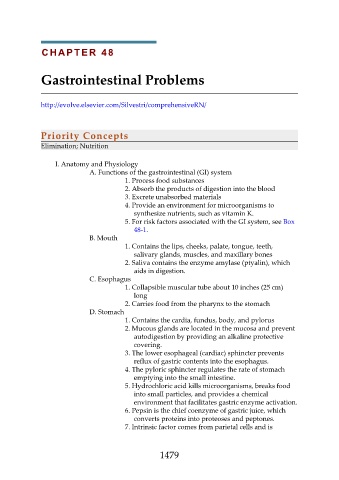Page 1479 - Saunders Comprehensive Review For NCLEX-RN
P. 1479
CHAPTER 48
Gastrointestinal Problems
http://evolve.elsevier.com/Silvestri/comprehensiveRN/
Priority Concepts
Elimination; Nutrition
I. Anatomy and Physiology
A. Functions of the gastrointestinal (GI) system
1. Process food substances
2. Absorb the products of digestion into the blood
3. Excrete unabsorbed materials
4. Provide an environment for microorganisms to
synthesize nutrients, such as vitamin K.
5. For risk factors associated with the GI system, see Box
48-1.
B. Mouth
1. Contains the lips, cheeks, palate, tongue, teeth,
salivary glands, muscles, and maxillary bones
2. Saliva contains the enzyme amylase (ptyalin), which
aids in digestion.
C. Esophagus
1. Collapsible muscular tube about 10 inches (25 cm)
long
2. Carries food from the pharynx to the stomach
D. Stomach
1. Contains the cardia, fundus, body, and pylorus
2. Mucous glands are located in the mucosa and prevent
autodigestion by providing an alkaline protective
covering.
3. The lower esophageal (cardiac) sphincter prevents
reflux of gastric contents into the esophagus.
4. The pyloric sphincter regulates the rate of stomach
emptying into the small intestine.
5. Hydrochloric acid kills microorganisms, breaks food
into small particles, and provides a chemical
environment that facilitates gastric enzyme activation.
6. Pepsin is the chief coenzyme of gastric juice, which
converts proteins into proteoses and peptones.
7. Intrinsic factor comes from parietal cells and is
1479

